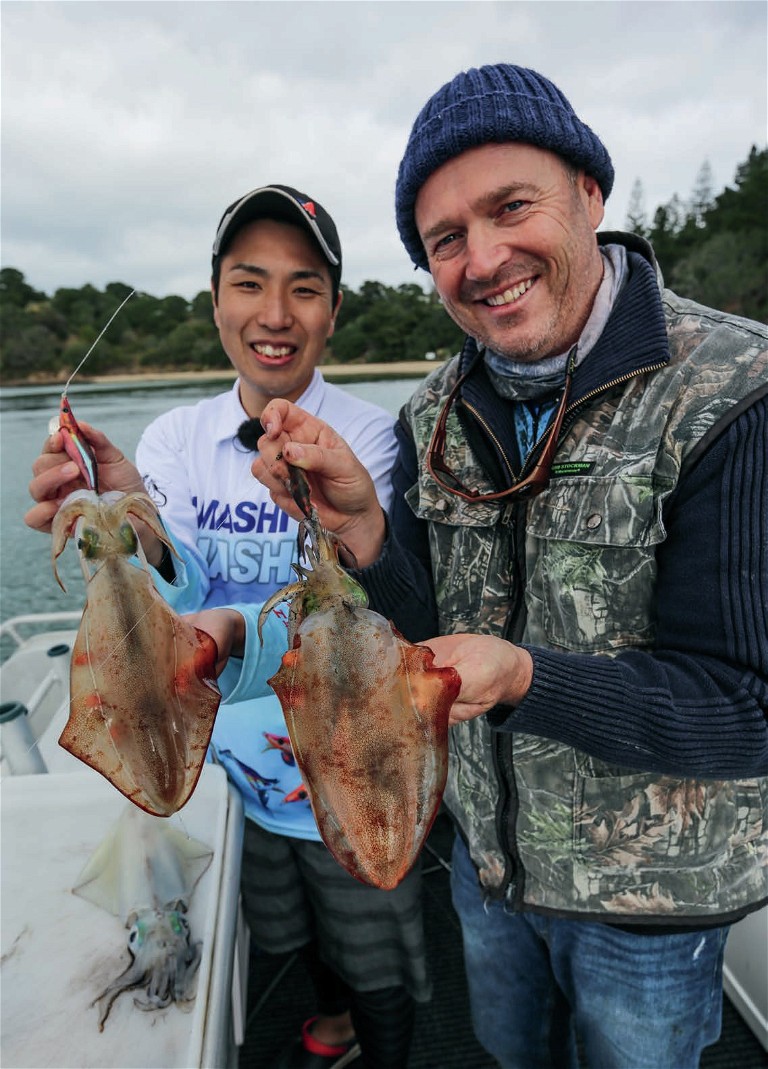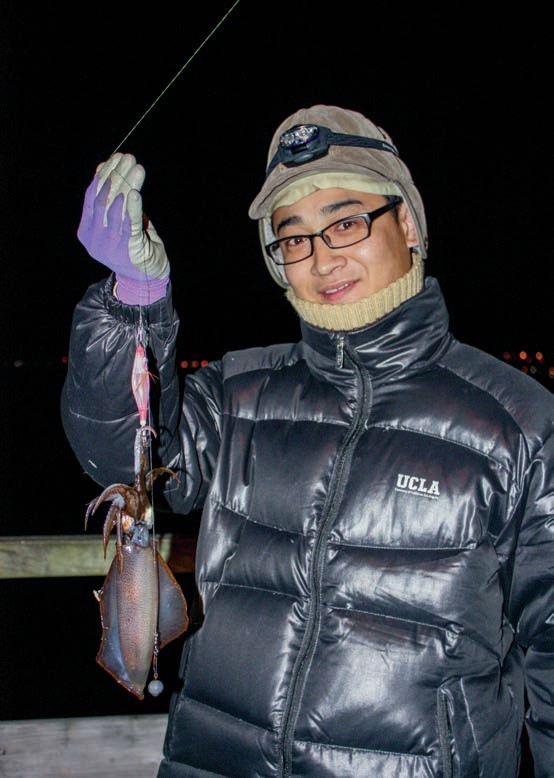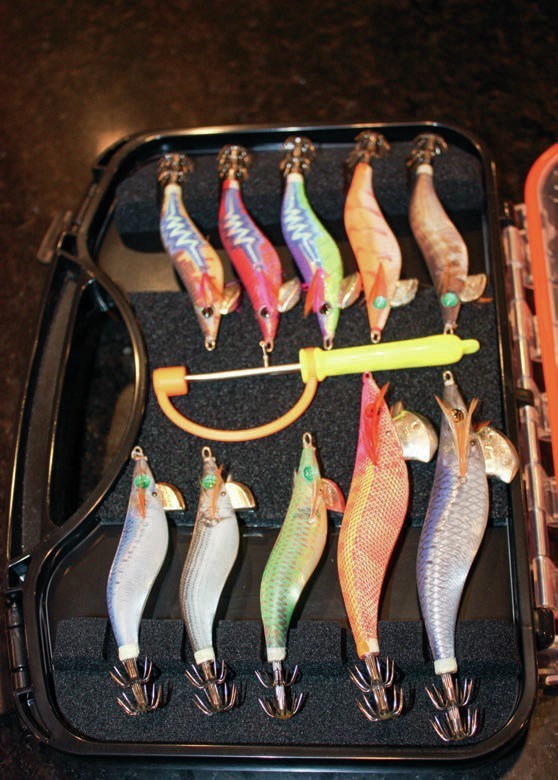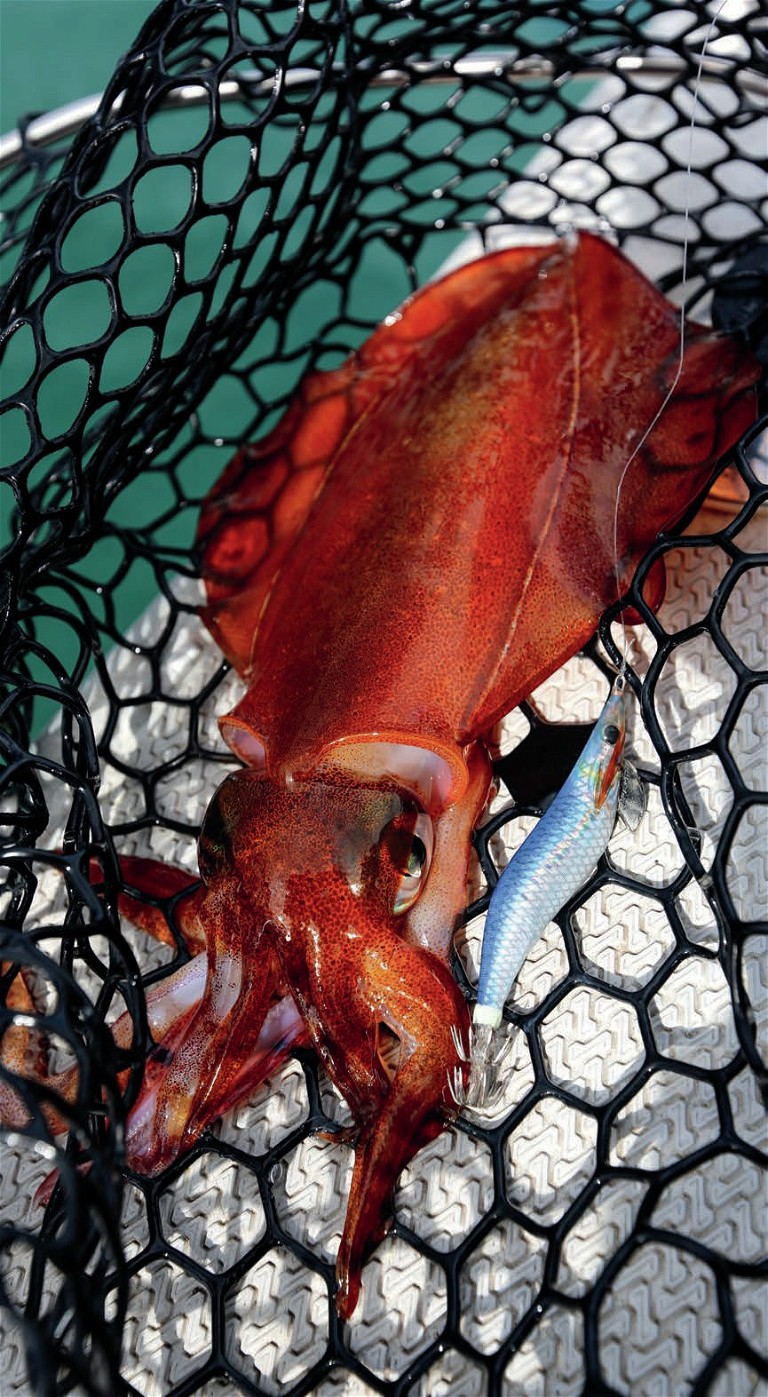Squid fishing
NO EGI ON MY FACE MATE! (PART 1 )
Mark Kitteridge confesses that he’s not a squid catching expert, but has been lucky enough to have fished with some of the best (including Yamashita’s globe-trotting specialist egi fishermen) and learned plenty from them.

The writer and friend Paul Senior (pictured) were lucky enough to be taught by the best, thanks to a visiting Yamashita specialist from Japan.
The first time you get a jet of ink, mixed with cold water, to the face and/or all over your clothes, you’ll vow to avoid another. Good luck with that!
Yep, squid - also known as egi - fishing can be a messy business, but as your experience grows the mess gets less.
Some squid basics
In New Zealand’s coastal waters we mostly target two species of squid: the broad squid and arrow squid. Broads tend to be encountered in relatively shallow waters accompanied by some current and with weedy structure present, while arrows are encountered in deeper, open ocean situations. Both can be caught by recreational egi fishers when using the right squid jigs.
Squid grow extremely quickly and have a lifespan of around a year; after spawning they die, with the baby squid emerging from late December/early January. Fortunately for us, although the best time for squid fishing (i.e. when they are become big enough to be made into a worthwhile meal) tends to be from late July/early August through to December, spawning variations mean large squid can be encountered at any time - just the chances become much less during the early months each year.
Although the arrows usually grow bigger - we have caught them to over a metre in length while out at the Three Kings Islands, as well as when drifting for broadbill at night - we once caught a monster broad squid around the same length on a soft-bait near Kawau Island!
The gear
The rod: Most squid rods are 8’-8’6” in length, forgiving in action (i.e. very whippy) and should be light in weight. Rods designed to be fished from the shore are often more powerful than those made for the boat, as they are sometimes required to cast the larger jigs to greater distances. Rods with casting capabilities of 5-20g ensure that most of the more common squidjig weights are catered for.
Note that although a light softbait rod may suffice while learning the ropes, it won’t be long before frustration at the low catch rate will lead to purchasing the right kit.
The reel: As squid are not strong fighters (only the biggest will pull a metre or two of line off against even a lightly-set drag), the reel need not be too expensive or large. Instead, check out small, light reels around the 2000- 2500 sizes equipped with a smooth drag.
Mainline: The reel’s spool should be well filled with light braid around 3-5kg breaking strain. The thinner the line and the higher the number of carrier strands (i.e. at least eight, but ideally 12/13), the better the squid-jig casting capabilities, especially when the smaller 2.0-2.5 jigs are being used.
Trace: Most of the better egi fishers opt for 2-3 metres of 10-15lb (4.5-7kg) fluorocarbon trace, but I often go up to 20lb when fishing around lots of weed as this extra strength enables most of my snagged squid jigs to be ripped free. However, when the water is clear and the squid are wary, it pays to go lighter, especially as the thicker traces also tend to dampen some of the jig’s natural movement.

Squid will sometimes take other types of jigs.

Bright, high-viz colours or lumo are good darkness options.

A typical starters kit, mostly consisting of 2.5 and 3.0 Yamashitas, in both natural and high vis colours.

Some thoughts on squid jig choice…
It’s tough being a squid-fishing beginner, as the squid-jig options are absolutely mind blowing!
In addition to squid jigs coming in sizes ranging from 1.3” to 4” (they extend beyond these sizes, but aren’t usually needed here) and zillions of different colours incorporating UV, fluorescent and luminous properties, squid jigs also vary hugely in their sink rates, finishes (mostly variations of cloth with differently coloured underfoils that peep out between the fibres, or smooth), chin-weight shapes and sizes. Then there are the wildly varying ‘individual properties’ such as: emitting a specifically-pitched rattling noise that imitates feeding activity and which also transmits through the water effectively; producing baitfish-type flashes when fished in daylight or under light at night; and having ‘thermal jackets’ that convert light both natural and manmade into heat, enabling them to be around a degree or so warmer than the surrounding water, same as the baitfish. The latter can make a lot of difference, as squid are very sensitive to temperature, making them more likely to be thoroughly tricked into grabbing and hanging on better so they will be hooked.
Having said all that, aspiring egi fishers will be able to accommodate most situations with just 2.5-3” models in a handful of colours. Unfortunately, that ‘handful’ can change according to the time of the year, water conditions and how much light is present, but as a generalisation they include:
Night time: Jigs incorporating pink and orange colours are often the most consistent producers, with red, green or blue also doing the job at times. Having an element of lumo in the squid jig can be very advantageous too, although pure black is surprisingly good at times as well - as can be variations on the pure white/ lumo/fluorescent theme!
Daytime: If conditions are calm and clear, the more natural colours (i.e. mackerel, pilchard and sprat imitations) are usually worth casting out first. But if the water is somewhat murky, the brighter fluoro colours may prove better producers. Choosing the right size Same as all types of fishing, ‘elephants do eat peanuts’ and sometimes small squid can be particularly ambitious in what they think they can eat - so there are no absolutes.
However, 2.5” is a good allround size to kick things off with; even if it doesn’t actually hook the squid present, they will often follow it in. Then, with their size ascertained, you can go up or down in the size of jig, or maybe change the jig colour or brand if they look suitable but aren’t committing to grabbing hold.
As is becoming obvious, the ability to chop and change the squid-jig colours, sizes and brands will often make a massive difference to your end results. That’s why you will also need a pack of small squid-jig clips - they make experimentation with the various options much easier!
Next month: squid Jig techniques from the shore and the boat…

Natural colours tend to work well in clear waters during the daytime.